

Introducing the Kühling&Kühling RepRap Industrial. We are excited to be able to finally publish first details on our new RepRap design after a full year of development.

As we mentioned earlier we went the extra mile and started from scratch instead of modifying an existing design in order to incorporate all features we desired. R2C2 For Rapman. Under construction Intro R2C2 is a new electronics board for RepRap printers and other devices.
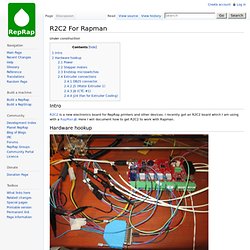
I recently got an R2C2 board which I am using with a RapMan. Here I will document how to get R2C2 to work with Rapman. Hardware hookup. Comparing Entry Level 3D Printers. This entry was posted on February 21, 2012 by Luke Chilson.
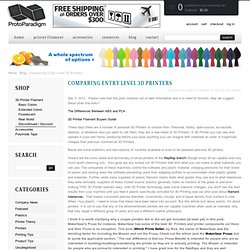
Dec 5, 2012 : Please note that this post contains out of date information and is in need of revision. May we suggest these other fine links? The Differences Between ABS and PLA 3D Printer Filament Buyers Guide These days there are a number of personal 3D Printers to choose from. Below are some statistics and descriptions of currently available or soon to be released personal 3D printers. Absent are the more varied and technically involved printers of the RepRap branch (though every bit as capable and very much worth checking out). I think it is worth clarifying why a couple printers did or did not get included (at least yet) in this post.
Time has gone into distilling the comparable features that will most decide the limits of what you can do with the machine. Stats Build Envelope The Build Envelope of a printer is maximum possible size of an object made by the printer. Box Comparison of Build Envelope Layer Resolution Linear Speed. 3D printing and 3D printers news, trends and resources. 3D printing with Color. After having a 3D printer for some months I've realized that it's so much cooler to use plastic with the "right" color, rather than just printing in black and white.
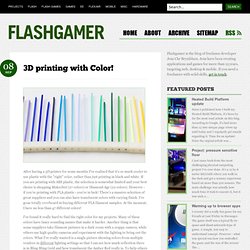
If you are printing with ABS plastic, the selection is somewhat limited and your best choice is shopping Makerbot (27 colors) or Diamond Age (22 colors). However - if you're printing with PLA plastic - you're in luck! There's a massive selection of great suppliers and you can also have translucent colors with varying finish. I've gone totally overboard in buying different PLA filament samples. At the moment, I have no less than 47 different colors! I've found it really hard to find the right color for my projects. Below you can find pictures of all my filament samples photographed outdoors in sunlight.
Click any of the images to go to Flickr for the high-resolution version (5000 pixels+). Note how the translucent colors change from white to the darker background Notice how the translucency does not show really well here? 3D Printing with Linux. What is 3D Printing?
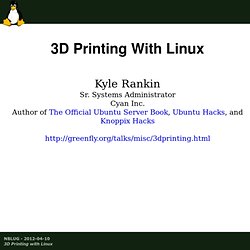
Types of 3D PrintersLaser-cut wooden box 3D printersRepRap familyOthersLinux 3D Printing SoftwareFirmwareSlicersUser InterfaceFirmware CalibrationSlicer CalibrationABS vs. PLA plasticCAD Software Printing three-dimensional objectsUsually in plastic, but also metals, ceramics, organic matterTraditionally used by companies for rapid prototypingTraditionally expensive ($15k-$250k+)Now available for hobbyists at more reasonable prices ($400-$2000)Can get reasonably good-quality prints with home machinesSites like thingiverse.com allow people to share 3D designs. Filament Tolerances and Print Quality. This entry was posted on November 29, 2011 by Luke Chilson.
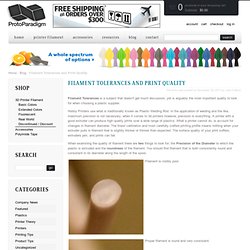
Filament Tolerances is a subject that doesn't get much discussion, yet is arguably the most important quality to look for when choosing a plastic supplier. Hobby Printers use what is traditionally known as Plastic Welding Rod. In the application of welding and the like, maximum precision is not necessary; when it comes to 3d printers however, precision is everything. A printer with a good extruder can produce high quality prints over a wide range of plastics. What a printer cannot do, is account for changes in filament diameter. When examining the quality of filament there are two things to look for; the Precision of the Diameter to which the plastic is extruded and the roundness of the filament. Filabot: Plastic Filament Maker by Tyler McNaney.
Filabot is a 3D plastic extrusion system.

For example mostly any type of recyclable plastic, such as milk jugs, detergent bottles, soda bottles, shampoo bottles, product packaging, and many more, can be processed through the Filabot to make usable 3D printing filament. This will allow for users to remake filament from an old print that is bad or not needed. The Filabot will grind, melt and extrude the plastic filament. It is a one stop shop for all the filament you could ever need. Plastic recycling and extrusion have been around since plastic was invented.
The Size of Filabot and Operation: Going along with the desktop theme, The Filabot will be designed to fit on a desktop. The grinding unit of the Filabot will process plastic up to the diameter of 4in, larger pieces will have to be broken down before feed into the grinder. After grinding the plastic will be a uniform size and will be automatically feed into the hopper. Finally the filament is rolled onto the spool for future parts. Abs filament - Jet_jet2004 / FREE Super Saver Delivery: Electronics & Photo. (99+) Ultimaker. Lost PLA Casting from 3D Prints. Molding with silicone (Kempton's bottle) The Ultimaker and makerbot parts come with the fresh smell of laser-cut plywood.

The use of wood is deliberate, as Ultimaker claim on their wiki page: “Wood is an incredibly strong material for its weight. Moreover, everyone can modify a piece of wood by sawing, drilling or filing away material. You can also paint it! We want you to feel free to modify your machine to your liking.” Background While Reprap remains a non-profit group researching in the area of open-source 3D printers, providing drawings and acting as a hotspot of ideas, new businesses like MakerBot and Ultimaker are emerging, offering the complete product bundled together, or as a ready assembled product. All though different in appearance and construction, all these printers share some common principles. The Ultimaker This article is mainly about my experiences with the Ultimaker, as it is the only 3D printer i have experience with. The reasons for buying the ultimaker were many. Printing out all the pieces of the lid. Richrap blog. Like many who print with natural PLA hollow objects start to look like good fun, they can be a little tricky to print but here are a few things I have printed so far and a few tips that worked for me - I printed a few things with the 'Fill' module turned off in Skeinforge, this is ok, but you only get one (fragile) shell 'outline' and no base or lid on your model, for me this seems to be a problem with 0.25mm layers, the material seems to collapse on itself.
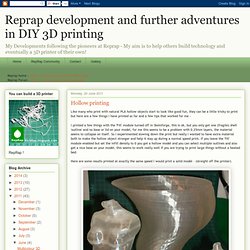
So I experimented slowing down the print but really I wanted to have extra material both to make the hollow object stronger and help it stay up during a normal speed print. If you leave the 'fill' module enabled but set the infill density to 0 you get a hollow model and you can select multiple outlines and also get a nice base on your model, this seems to work really well if you are trying to print large things without a heated bed.
Solid base on the legs gives it a really good grip on the bed. Rich. Timelapse photography.
So many printer & brands. Vitamins.